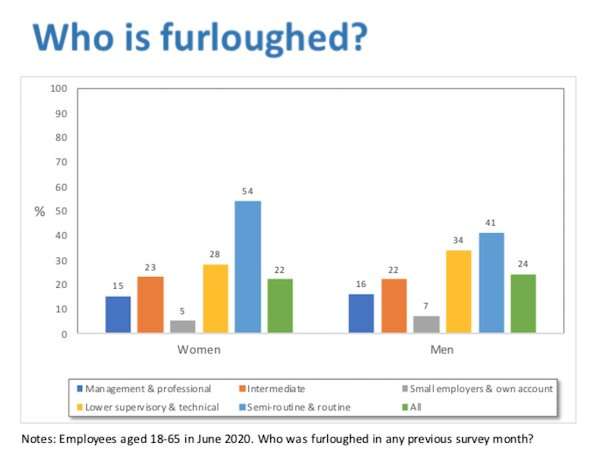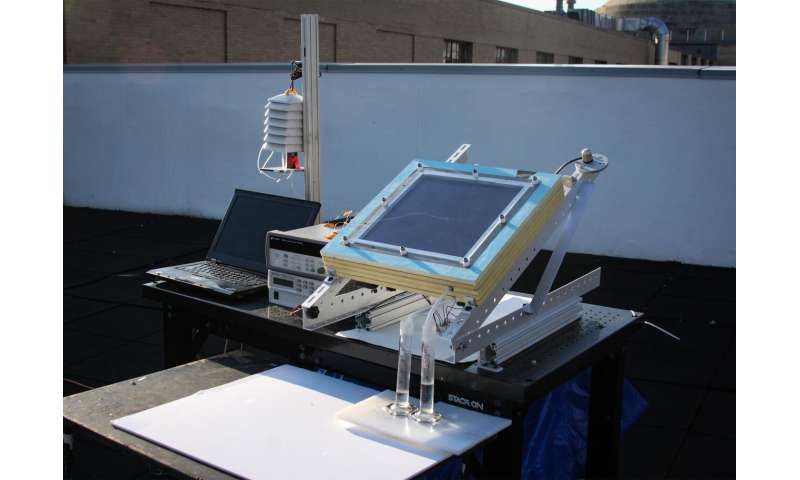by Gertrud Lindner, ETH Zurich

Credit: CC0 Public Domain
Since 2014, "equal! The Office of Equal Opportunity and Diversity" has documented the status of equal opportunities for men and women at ETH Zurich in an annual Gender Monitoring report. The latest report has been renamed "Equality Monitoring," as it also addresses the topic of diversity.
The recently published report, Equality Monitoring 2019/20, records an encouraging peak in the number of female professors at ETH Zurich. This leap forward owes much to the endeavors of the President and the Departments to appoint more women in a targeted way. In 2019, half of all new appointments to assistant professorships went to women, and 21 percent of permanent professorships. "I'm delighted to see that the bundle of measures we've taken is now having an impact on appointments. But these are just the first steps," says ETH Zurich President Joël Mesot.
Indeed, there's still much to be done: Women are still underrepresented at every academic career stage at ETH Zurich. For example, across all degree programs, just under a third of students are women—with only a tenth in some, and well over half in others. Only one in seven permanent professorships is filled by a woman.
Losses along the career path
Little has changed in the leaky pipeline. "The proportion of women declines from Master and doctorate level up to professor level, and this drop is more pronounced in some departments than others," says Renate Schubert, the ETH President's delegate for Equal Opportunities with responsibility for Equality Monitoring.
By means of the Gender Parity Index (GPI), ETH Zurich departments can be divided into three categories: those with a high overall proportion of women among students, doctoral students, academic staff, professors and technical-administrative staff, those with a medium and those with a very low overall proportion. Departments in the latter category, in particular, have now launched a raft of activities to ramp up the proportion of women. "We've noticed that the departments in the midfield are not really endeavoring to attract more women," states Schubert.
Even in departments with a high proportion of female Bachelor's and Master's students, the proportion decreases from doctoral level onwards. Nonetheless, Renate Schubert is optimistic. A growing number of female professors are proving that they are excellent and that a commitment to research, teaching and innovation is compatible with family life. This, she believes, will encourage young women to tackle the next academic level.
Diversity begets excellence
The authors of Equality Monitoring consider that a diversity strategy is crucial for universities, and it also fosters excellence. People working in a diverse research environment are more creative; they come up with unconventional research questions that generate innovative ideas, which are then transferred to practice. For students too, diverse learning environments are more stimulating and instructive, and therefore more productive than homogeneous ones.
But to achieve such diversity, the recruitment process and research and teaching evaluations must be designed to harness and develop the talent pool of very many, very different people. Maintaining and promoting diversity is costly and calls for considerable effort. It is something ETH Zurich has committed to with a number of initiatives, such as the Gender Action Plan, the Respect Code of Conduct, the Fix-the-Leaky-Pipeline Program, the creation of Gender and Diversity Advocates in appointment committees, and the implementation of the concerns of LGBTIQIA+ and other groups. These activities are to be consolidated and enhanced.
Painting a clearer picture
The Equality Monitoring report documents the degree of internationalization and the gender and age structure of ETH members. Other aspects of diversity, such as religion, sexual identity, or physical and mental disabilities, are sensitive data that is not currently collected at ETH Zurich. "It would be great if these aspects could be recorded in staff and student surveys in the future," says Renate Schubert. Such information would be provided voluntarily. For ultimately, "only if we have pertinent data can we grasp the crux of the diversity issue," she asserts.
Valuing diversity will create great opportunities, and ETH Zurich is right on track here. But there's still potential to increase diversity in all areas of the university; the Office of Equal Opportunity and Diversity will not be short of work any time soon.
Explore furtherTargets bring more women on boards, but they still don't reach the top
More information: ethz.ch/content/dam/ethz/assoc … eport_19-20_engl.pdf
Provided by ETH Zurich
1 shares
Facebook
Twi
Since 2014, "equal! The Office of Equal Opportunity and Diversity" has documented the status of equal opportunities for men and women at ETH Zurich in an annual Gender Monitoring report. The latest report has been renamed "Equality Monitoring," as it also addresses the topic of diversity.
The recently published report, Equality Monitoring 2019/20, records an encouraging peak in the number of female professors at ETH Zurich. This leap forward owes much to the endeavors of the President and the Departments to appoint more women in a targeted way. In 2019, half of all new appointments to assistant professorships went to women, and 21 percent of permanent professorships. "I'm delighted to see that the bundle of measures we've taken is now having an impact on appointments. But these are just the first steps," says ETH Zurich President Joël Mesot.
Indeed, there's still much to be done: Women are still underrepresented at every academic career stage at ETH Zurich. For example, across all degree programs, just under a third of students are women—with only a tenth in some, and well over half in others. Only one in seven permanent professorships is filled by a woman.
Losses along the career path
Little has changed in the leaky pipeline. "The proportion of women declines from Master and doctorate level up to professor level, and this drop is more pronounced in some departments than others," says Renate Schubert, the ETH President's delegate for Equal Opportunities with responsibility for Equality Monitoring.
By means of the Gender Parity Index (GPI), ETH Zurich departments can be divided into three categories: those with a high overall proportion of women among students, doctoral students, academic staff, professors and technical-administrative staff, those with a medium and those with a very low overall proportion. Departments in the latter category, in particular, have now launched a raft of activities to ramp up the proportion of women. "We've noticed that the departments in the midfield are not really endeavoring to attract more women," states Schubert.
Even in departments with a high proportion of female Bachelor's and Master's students, the proportion decreases from doctoral level onwards. Nonetheless, Renate Schubert is optimistic. A growing number of female professors are proving that they are excellent and that a commitment to research, teaching and innovation is compatible with family life. This, she believes, will encourage young women to tackle the next academic level.
Diversity begets excellence
The authors of Equality Monitoring consider that a diversity strategy is crucial for universities, and it also fosters excellence. People working in a diverse research environment are more creative; they come up with unconventional research questions that generate innovative ideas, which are then transferred to practice. For students too, diverse learning environments are more stimulating and instructive, and therefore more productive than homogeneous ones.
But to achieve such diversity, the recruitment process and research and teaching evaluations must be designed to harness and develop the talent pool of very many, very different people. Maintaining and promoting diversity is costly and calls for considerable effort. It is something ETH Zurich has committed to with a number of initiatives, such as the Gender Action Plan, the Respect Code of Conduct, the Fix-the-Leaky-Pipeline Program, the creation of Gender and Diversity Advocates in appointment committees, and the implementation of the concerns of LGBTIQIA+ and other groups. These activities are to be consolidated and enhanced.
Painting a clearer picture
The Equality Monitoring report documents the degree of internationalization and the gender and age structure of ETH members. Other aspects of diversity, such as religion, sexual identity, or physical and mental disabilities, are sensitive data that is not currently collected at ETH Zurich. "It would be great if these aspects could be recorded in staff and student surveys in the future," says Renate Schubert. Such information would be provided voluntarily. For ultimately, "only if we have pertinent data can we grasp the crux of the diversity issue," she asserts.
Valuing diversity will create great opportunities, and ETH Zurich is right on track here. But there's still potential to increase diversity in all areas of the university; the Office of Equal Opportunity and Diversity will not be short of work any time soon.
Explore furtherTargets bring more women on boards, but they still don't reach the top
More information: ethz.ch/content/dam/ethz/assoc … eport_19-20_engl.pdf
Provided by ETH Zurich
1 shares
Twi
 Figure showing risk factors, and clinical presentation, management and outcomes for men and women Credit: European Heart Journal
Figure showing risk factors, and clinical presentation, management and outcomes for men and women Credit: European Heart Journal







 A prototype of the new two-stage water harvesting system (center right), was tested on an MIT rooftop. The device, which was connected to a laptop for data collection and was mounted at an angle to face the sun, has a black solar collecting plate at the top, and the water it produced flowed into two tubes at bottom.Credit: Alina LaPotin
A prototype of the new two-stage water harvesting system (center right), was tested on an MIT rooftop. The device, which was connected to a laptop for data collection and was mounted at an angle to face the sun, has a black solar collecting plate at the top, and the water it produced flowed into two tubes at bottom.Credit: Alina LaPotin Credit: Pixabay/CC0 Public Domain
Credit: Pixabay/CC0 Public Domain